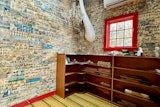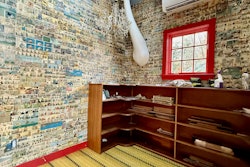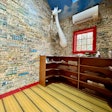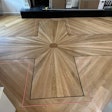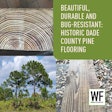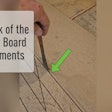Defining ‘Normal’
Why does the NWFA say that “normal” humidity levels should be between 30–50%, when those conditions cannot be maintained in many parts of the country?
Brett Miller, VP of education and certification at the National Wood Flooring Association, answers:
Where I’m from, 30% RH would be considered high through much of the calendar year. Being a native to one of the driest, high-desert regions in the country, I have a pretty solid understanding of how wood floors are being installed—and have been installed for many, many years—with minimal issues.
Yes, “normal” conditions in NWFA Guidelines are stated to be between 30–50% RH. We do not pull these out of thin air, nor do we publish them to appease what is written in manufacturers’ guidelines. When referencing the “Moisture Content of Wood at Various Temperatures and RH” chart from the U.S. Forest Products Laboratory, you will see the level at which most wood is dried and put in use—6–9% MC—coincides with the temperature being 60–80 degrees Fahrenheit and the RH being between 30–50%.
The Environmental Protection Agency (EPA) indoor air quality assessment model recommends relative humidity levels be maintained between 30–60% but also notes that maintaining RH below 50% will also control dust mites. The Occupational Safety & Health Administration recommends employers maintain humidity controls somewhere between 20–60% and a temperature range of 68–76 degrees. Why? Because generally speaking, this keeps people comfortable.
RELATED: Can We Be Proactive in Preventing RH Problems for Wood Floors?
American Society of Heating Refrigeration and Air Conditioning standard 55 (from 2010) states the optimum RH is between 30–60%. Bacteria thrives when RH is below 30 and above 60, and viruses thrive when RH is below 50 and above 70. Fungi grows with RH levels above 60. Mites thrive with RH levels above 50. Respiratory infections become worse when RH drops below 50. Allergic rhinitis and asthma become worse outside of the 30–50% mark. Ozone productions become worse with lower RH conditions.
So how do I, and others in the dry desert regions, do it with minimal issues? Sell and install products you know perform in drier climates, including more stable species, cuts of wood and products. Educate the customer on the importance of supplemental humidification during the winter months. Acclimate/“condition” the flooring to the expected living conditions. Don’t treat every job site the same. If the homeowners want a product that cannot sustain the conditions in their home, don’t install it!
Trapped Moisture
I installed a prefinished engineered floor in a home last year, and by spring the floor was buckling. An inspector said it was because of the greenhouse effect. What is that?
Matt Thrane, technical service/training specialist at Butler, Wis.-based Gehl Flooring, answers:
Usually here in the Midwest, during the winter months we deal with floors that shrink due to the loss of moisture from our heating systems, but sometimes an unoccupied home traps moisture—something we call the greenhouse effect—and the floors suffer. I recently inspected a floor like yours; going over the details of that case can you help understand why this happens.
In this case, due to the home being 15 feet from the edge of a lake, the contractor had installed engineered flooring. He had given the floor time to acclimate, and the home was at normal living conditions when he installed it over a crawl space onto a plywood subfloor using the recommended fasteners with the correct spacing. So, what changed? When I inspected it, the home’s maintenance manager explained it was a vacation home, and the floors needed to be fixed before the homeowners returned for summer. This triggered questions regarding the home while unoccupied. The manager stated that every time he checked on the house, he noticed it felt humid and would adjust the HVAC system. He said the homeowners have remote access to the HVAC system via the Internet, and when he would make corrective changes, the homeowner would remotely shut it down to conserve energy.
RELATED: How Inside Air Affects Wood Floors
Because we were coming out of winter and into spring, the crawl space was taking on moisture. In addition to that extra moisture, the homeowner was unknowingly creating the greenhouse effect due to the lack of air movement, allowing the moisture to be trapped in the house without adequate ventilation.
It is up to us as an industry to inform consumers about maintaining a stable environment in their home. There are monitoring systems available; some have been around for years for data logging purposes, and now, consumers can receive alerts on their mobile devices that the conditions around their floors may have gone out of the stable range—that is an additional way you can help customers protect their investment.









